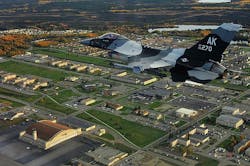US Air Force selects Oklo Microreactor for Power Project at Alaskan Base
A startup working to develop nuclear fission power plants has been awarded a contract by the U.S. Air Force to install one of its microreactors at a base in Alaska.
Oklo Inc. would site the nuclear microgrid to power Eielson Air Force Base southeast of Fairbanks and near Moose Creek. Eielson is home base to the USAF’s 354th Fighter Wing and serves as site for dozens of Lockheed Martin F-35 Lightning II aircraft.
In a year with numerous gains for future development of small modular reactors and other advanced nuclear technologies, Oklo secured a contract with the USAF and U.S. Department of Defense, although its project still requires a final license from the Nuclear Regulatory Commission.
Once approved, developed, constructed and commissioned into operation, the Oklo-owned fast reactor would produce electricity and steam directly for the Eielson AFB under a long-term power purchase agreement.
“We are honored to be at the forefront of increasing resilience and reducing emissions, while driving national security forward,” Oklo Co-Founder and CEO Jacob DeWitte said in a company statement.
The Air Force’s microreactor pilot program was initiated under the 2019 National Defense Authorization Act. Nuclear energy currently generates about 20% of the U.S. utility-scale electricity mix and more than half of its carbon-free power.
Earlier in August, Oklo announced a new memorandum of understanding with Centrus Energy Corp. for the latter to supply advanced nuclear fuel produced in southern Ohio. High-assay, low-enriched uranium (HALEU) is the type of nuclear fuel set to be used by Oklo's microreactor and produced by Centrus at its planned Piketon, Ohio production plant.
If completed, the Eielson Base project would be the first on-site nuclear microreactor installed by the military directive. No timeline was given in the recent announcement, but the U.S. Air Force set a 2027 date for microreactor operations when the Eielson site choice was announced in 2021.
A recent story in Microgrid Knowledge noted that interest in using small modular reactors for microgrids was growing as SMRs begin gaining federal regulatory approval and investment momentum. Some 80 reactor designs are not under development worldwide, but only one—the two-module reactor aboard the Akademik Lomonosov floating power unit in Russa—is in commercial operation.
A model developed by software firm Xendee and the Idaho National Laboratory—a big supporter in testing new nuclear technologies—updated modeling showing users how to compare the economics of adding future SMRs to microgrids.
“In principle, the model can consider costs for disposing nuclear waste, but those costs were not considered in the latest runs, which indicate that small reactors can be economically attractive,” said Michael Stadler, Xendee Co-Founder and Chief Technology Officer.
Related stories
Will the Microgrid Industry or Public accept Small Nuclear Reactors?
A Nuclear Microgrid? National Lab sets out to test the idea
Subscribe to Microgrid Knowledge's free email newsletter
Some critics have questioned the operational challenges of microreactors and SMRs because of geographical safety concerns and the disposal of nuclear waste in spent fuel. Other sources, such as the U.S. Department of Energy, have countered that the actual amount of all spent fuel generated since commercial nuclear energy operations began in the 1950s would barely fill the size of a football field 10 yards deep.
The U.S. alone has more than 90 working nuclear reactors, including two new units built at Georgia Power’s Vogtle plant.
Siting new nuclear facilities near population centers would present key challenges and potential threats, critics say.
Last year, Mike Byrnes, Senior Vice President of facilities and building services at Veolia North America, told Microgrid Knowledge that siting microgrids with nuclear reactors would be challenging. By definition, microgrids are located close to the load.
“Who’s going to want a nuclear reactor where they live?” he asked.
Supporters argued that no U.S. residents died as a direct result of radiation from a U.S. nuclear plant mishap in history, including the best-known accident at Three Mile Island in Pennsylvania 44 years ago, according to numerous reports. Another defense is that nuclear energy has saved lives compared to air pollution emitted by fossil fuel power plants.
Critics, however, noted that some accidents have caused injuries, eventually leading to death among workers.








